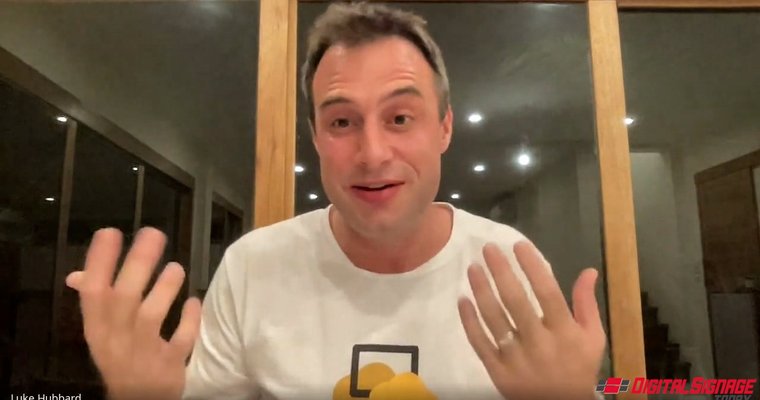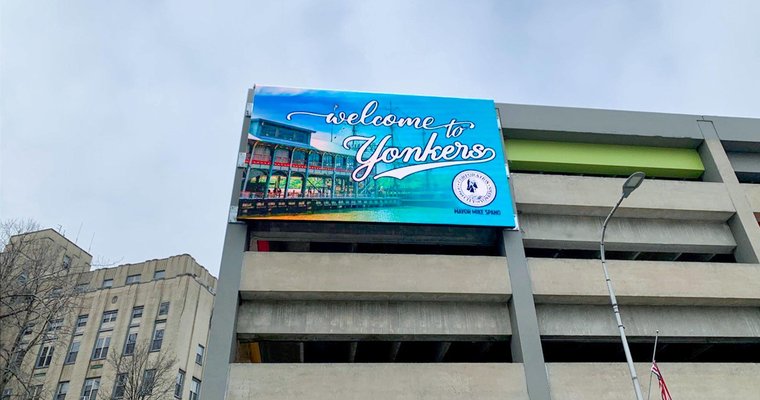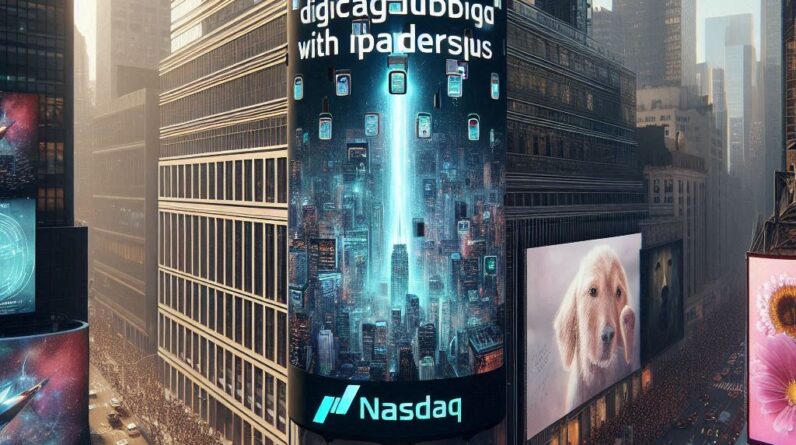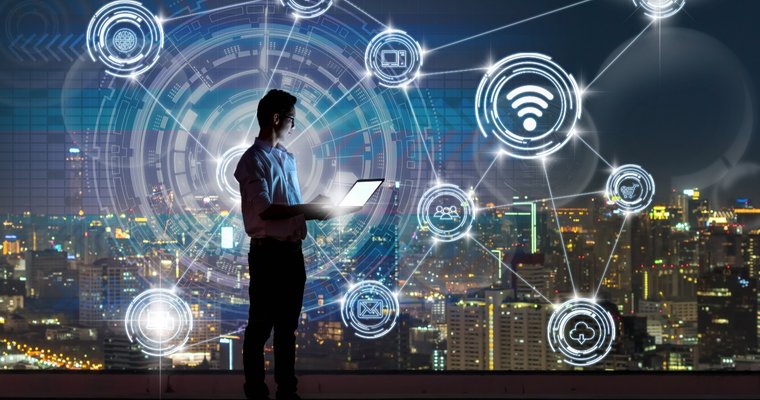
[ad_1]
Luke Hubbard, CTO at ScreenCloud, joined Digital Signage Today editor Daniel Brown via video link from his home in Bangkok, Thailand to discuss the trends in digital signage, AV, business and technology related to AI, Google’s signage ambitions and more.
 Luke Hubbard. Image credit: Daniel Brown/Networld Media Group.
Luke Hubbard. Image credit: Daniel Brown/Networld Media Group.
Which way is up?
With ChatGPT launching an AI arms race, the dizzying changes in business and technology are transforming not just digital signage but business and technology as a whole.
Luke Hubbard, CTO at ScreenCloud, joined Digital Signage Today editor Daniel Brown via video link from his home in Bangkok, Thailand, to discuss the trends in digital signage, AV, business and technology and offer insights as a technology expert, programmer, business leader and digital citizen on strategies to navigate and prosper during what Hubbard sees as an historic moment of nearly unprecedented change for the human species.
Hubbard also mentions that “coopetition” and collaboration across the industry will be key in making the most of this new world; that creativity is what drives him through even the challenging parts of the job and that the future of AI will involve creating a personalized portal or conduit, assistant if you like, to access the AI-powered tools that are being developed at an exponential rate.
The full video is available below.
Interview and transcript have been edited for brevity and clarity.
Video credit: Daniel Brown/Networld Media Group. |
Video Transcript
Transcript generated by Otter.ai, with some corrections by editorial staff.
Daniel Brown:First of all, how are you, Luke? Thank you for joining us what’s going on with you? And with your work?
Luke Hubbard:Yeah, I’m good. Thanks. There’s a lot going on with work. Some stuff I can’t announce, but you will come out very soon. Yeah, it’s coming soon. We’ll give you the release when it comes out. No, we’ve been good. We’ve been busy. Obviously, I guess you’re alluding to, you know, what’s been happening with AI and the pace at which things are moving forward. And the implications of that for digital signage is immense. I mean, in that piece, we touched on it. And we talked about AI being used to kind of control what was shown with feedback loops and stuff like that, and I, but I think the, you know, since GPT, is, you know, hit the mainstream now, the possibilities for digital signage are immense, really, and there’s a lot of low hanging fruit, kind of like, we’re kind of exploring both ends, the stuff that’s just obvious, and will easily work, and it really doesn’t take very long to hook up. And then there’s, like, you know, stuff where it’s like, this completely changes the game, but you kind of got to start, again, from a core of just AI. So we’re kind of exploring both ends of that spectrum.
Brown:Now, as an expert in the space, maybe you can help me because there’s so much hype. And of course, I’m staying up late reading all these articles about, you know, the death of journalism, or the death of fiction (I’m a fiction writer), all these things. And I think there’s a lot of negative hype, but there seems to be some really positive potential here, too. Can you speak to that a little bit? What is coming down the pike? And are we living in the Star Trek days now?
Hubbard:I think it’s kind of coming very fast, we were on an exponential curve, right? Which it’s very hard thing for humans to understand, our brains just don’t really understand that. It’s just like, we can say it, we can look at it and try to draw it. But we were really just, yeah, we’re about to live through another one. I would say, for digital signs, specifically, what the biggest thing is understanding context, context changes the game in kind of spatial computing. Because if the screen and application on screen can understand who the user is, what they want, what they’re doing, what their job is, where they are, what’s happening with, you know, let’s say logistics of that environment, it can be so much more useful. And so we can go from this, essentially just broadcasting out information, essentially, I mean, it’s kind of moving beyond them dumb screens, into screens, that, you know, you can just talk to you that they will be up. And that’s a different kind of application. Because, up until now, operating systems have just been, you know, point and click, we tap things about, we do all the control as humans, we do most of the work, right. Whereas if the AI can understand the context of what the users doing, what application you want, stuff like that, then it becomes more of a conversation. And that’s very natural via voice. As long as the thing you’re talking to understands and isn’t like, you know, stupid. So, I think we’re kind of reaching that point where soon, you know, interaction is going to get like, the doors are going to be blown off the potential of what we can do with screens. But yeah, then there’s also I mean, that’s just that, I’m really excited about that kind of edge to it, because I think it opens up a new kind of computing almost, but when we kind of pull it back to Okay, what else can we do with this technology? Well, you know, it is content summarization, taking like a PDF, or a press release that’s been released, and then summarizing the content, turning it into content that would be fit for essentially a poster advertising something, or that then or, you know, like, we’re translating stuff from one language into another, that’s a big deal for us, because we work with a lot of deskless workers, and they speak in various languages. So just being able to take existing feeds of content and say, on the fly, translate this into another language, and you know, render it out — all of that. And then that’s it. I’m not even touched on like the UI layer. Basically, the UI layer, at some point is going to get replaced by AI-generated interfaces, in the same way that we see kind of see with generative art and stuff, right, that’s kind of pixel-based, essentially, starting with random noise. And then slowly changing until we have this amazing graphic. Well, AI can do that with code, and CSS, and all of those component parts. And right now the AI is kind of blind. It’s just generating code based on what it thinks. And it’s not yet seeing what it’s doing, if that makes sense. So, once you close that feedback loop, and the AI can see what it’s generating, in the same way a developer kind of, you know, sent as a div is the classic example of like, you mess around with CSS and say, Okay, now it’s centered. That’s good. The AI can do the same thing. And then, you know, that’s every one of them like a ticking clock as it were, as it goes forward. So, it will just, the generation will get better. So yeah, so I can kind of see like, big, big parts of the industry will change.
Brown:Well, it’s interesting you say that, forgive me, I get so excited that I jump in, but it feels as if every time I test these new tools and you know, spend a couple of weekends testing this Dall-e and all these different generative things, but there’s not a self-corrective executive function, as it were, where it’s saying, okay, but is this actually giving the outputs that I want? How do I tweak the outputs? Why is that missing? And I’ve heard people when I talked to like experts in the space who are way smarter than me, they kind of blanche when I say artificial intelligence, they’re like, no, no, no, it’s just machine learning. I think David Colleen said at one time, so no, no, it’s mynah birds. They’re just mynah birds. What’s that all about?
Hubbard:I mean, is only predicting the next word or the next token, right, it is kind of that it is can hallucinate, it can be done. It can, it is all of that. But it’s, what I found is that and I think people miss somewhat when they just use, say, the chat interface or something like that is, is that it’s about their own context. And it’s almost like you’re giving the giving the AI guardrails or guidance as to what space you want it to play in. And then you give it a very specific task to do. And it can get very good at doing those small tasks. And if you then take those system and decompose it into pieces, and then have other bits that supervise other parts and etc. So you basically like rather than have it, try to let it do everything that you can just tell it write a book, and it will, but it’s much better to kind of break it down into small pieces, and then have them run in isolation.
Brown:I guess the analogy might be, you know, we’re trying to ask this poor thing to do all these outputs from coding to, as you say, creative stuff. But if I was a publisher, and I was hiring someone to write a romance novel, I want a brain that’s been trained in the special set of data for 25 years and knows what people want.
Hubbard:Life and everything else. Right. It’s like, it’s like a baby that’s just coming out. It hasn’t opened his eyes yet. And we’re going oh, look, it’s you know, it can only do basic math, or, you know, oh, look, it’s sort of getting this wrong stuff. Like maybe
Brown:Baby Terminator! It goes up so fast!
Hubbard:Yeah, exactly. Like we’re about to, you know, go for exponential teenage years at some point. So just these additional capabilities that basically it treats everything as a token, right, so words or music or anything we can turn into tokens, we can then feed into the system, and it can then generate stuff. So So yeah, it’s kind of mind blowing, where that potential goes, I think it will revolutionize software development, for sure. But I’m excited about screens. Because it’s a, it’s like a new space, like, well, I describe it like this. This is my mobile phone, right? It’s my personal phone. This is my personal computer, right? In the 1980s, we kind of split into a world of personal computing. And back then some people were like, worried that we’d end up in a world in which we’re all glued to our devices, like the devices would suck us in, and it kind of did come to play, right? It just required a dopamine, dopamine loop and internet. And suddenly, we’ve got everyone glued to their phones. But they wanted a world in which computers kind of were in the background, you know, they were there to help me, they came up when they needed and they did stuff for us. And they provided stuff, but it didn’t demand our attention. They didn’t suck us in. So that kind of idea of like, what does kind of pervasive computing or ubiquitous computing, how does that work? What does that look like? And then how does AI enable that, I think is really interesting. But it’s also kind of Greenfield space, because we have interfaces, we have operating systems, we have apps, we have everything on our personal devices, but on these screens. It’s still very nascent, right? It’s very basic, like when we share interactions, maybe it’s like a QR code, you fill out a form, or, you know, it’s definitely not like a full, normal computing experience. I think every — all the pieces are there, you know, we just need to read web rendering surface, connection to the internet, and a connection to the AI. And then it’s got the inputs and outputs required to do that.
Brown:This is basically — the future is going to be it sounds like the ultimate personalization across advertising across screens, a single pane of glass that people have been seeking the Holy Grail, right. And this is something that kind of drives me nuts. I love technology I have since I could walk. I’ve been in love with computers, but it drives me batty. You’ve got a system that is tailored to 8 billion people now. Well, that’s not tailored. It’s not personalized. What about the accessibility? What about my unique quirks and personalities? And sounds like from what you’re saying? We’re getting to systems that can customize themselves for the user and also self-correct. Is that Is that fair to say?
Hubbard:Yeah, definitely. I mean, we’re going to see a new breed in operating systems for sure. And there’ll be you know, the major tech companies will push forward in different ways. And as it seems obvious that we’re going to have some sort of agent that’s our personal agent. That’s like the entry point to this, right. That’s the race: to become the agent. I’d like to see that be more pluggable so people can kind of choose their agent and people can experiment with different ones and stuff like that, but whatever this kind of entity or I mean, I don’t really want to anthropomorphize it. But like, it’s a thing we talk to, let’s say that we that we trust, and that is part of this operating system, that’s going to need to output on screens, it’s going to need to interface with all the devices around you. So that’s fine. Like, the bit where I’m focused is, okay, we’re probably not going to be building the core brain that you talk to. But let’s let whatever that is that’s coming, that will come from different angles from different companies, let’s that we later reach out and get to all the human potential web connected displays, in your business, in your in your home, etc. So we can kind of, yeah, display wherever it needs to display.
Brown:It’s so hard because in our industry, it’s like, it’s becoming less siloed. But it feels like there’s hardware folks, and then there’s software folks. And then there’s more tech folks, and there’s different — How do folks in our industry, prepare, get ahead of thrive in this almost black box future that we’re heading into? And I don’t want you to give way, you know, secrets, but in general terms, what can folks start doing to prepare?
Hubbard:Um, okay, that’s an interesting question. I was thinking about this actually, earlier. And I think the things I mean, a lot of the things we’re doing and not like, you know, super cutting edge and pushing on the — we’re in experimentally stuff, but there’s a lot we’re doing, it’s just like, stuff that has to get done. And a lot of that is connecting up different business systems, ensuring that you have access to the data to operate on, because we’re soon going to have systems and things that can operate on this data and extract meaningful stuff out of it, and process it and do wonderful things. But like, just getting ready to be able to make sure that the data is in an accessible format, or the data is available, and you’ve got API’s and stuff like that, that can take quite a while. So I think that kind of preparation. So, if you’re a business and you’ve got business systems or whatever, and you’re preparing this, I will be looking to ensure that you make sure you’ve got access to all the various bits of data that you want a system that is intelligent and can access that data to have access to.
Brown:Is this, is this change as big as I heard someone say the other day, you know, this is like when the Internet first became a consumer product. And people were like, this is going to be big. Do you feel like this is similar?
Hubbard:Yeah, I do. I mean, I’ve been over 20 years in tech. And I don’t think I’ve seen a moment quite like this. I lived through the Internet starting but it wasn’t consumer internet. But it didn’t seem to happen, like, overnight, they got going around 2000, right. It’s like getting hyped up and stuff like that. But it was going for quite a few years before that slowly growing. This feels like you know, a matter of months and weeks, everything’s just moving so fast. And with the capabilities and the obvious trajectory, it’ll unlock many more things. So, you can now imagine things that were not possible before or seemed they were distant, they now seem quite possible. It’s just a matter of people putting the pieces together, right, and that process will accelerate and so on. So, I think we’re in for a bit of a wild ride. And just I’m sure you’ve experienced recently the number of products getting launched. And it’s kind of like, I think, right now, there’s a lot of people adding AI to products, where it’s like low hanging fruit. It’s obvious, right? Like, I was having discussion today about translations for websites. And you know, maybe would have an AI feature to translate content in their website. So, it seems an obvious thing for them to add. But I think, you know, give it a little bit more time. And we will get much more sophisticated systems coming online. So, you know, developers haven’t had that one to kind of really build on this stuff yet.
Brown:One of the other changes that I’ve seen is I hear so much about Google Chrome. And it’s, it’s trying to move into the signage space in a way I haven’t necessarily seen before, is one of the major players. And what do we need to watch for here? Because you just recently announced some news about Google.
Hubbard:Yeah, we’ve on the Chrome Enterprise Recommended Program now as approved, partner, which is, which is wonderful. And we’ve worked with Google for many years. So, it’s nice to kind of, you know, finally have a partnership there and have access to experts and just that level of some help and support really.
Brown:Tell me more about that, though, because I’m so curious. Because when you say access to experts, it’s a very interesting, we did a little press release news item about it. But what exactly does this new certification mean for you guys? And should other people be looking at Hey, we should get this too?
Hubbard:Yeah, I don’t see why not. I mean, there’s two sides to it. There’s a, there’s a more business side of it, where you work with Google sales team, and so on is kind of on opportunities and that side of things, which is obviously wonderful for a business to unlock that, and we’re excited for the potential there. But on the engineering side, there’s kind of a greater degree of access to the, you know, the Chrome digital signage team, and then also just the Chrome team themselves. So, you know, and that’s useful for us. Chrome OS, and it’s useful for us and other platforms as well, whenever we can actually talk to the developers working on the core bits of technology, we can kind of put forward our viewpoint or ask for certain features, or just kind of like, tell them how we feel about how, where things are going. When I think about Google in a digital signage space, I mean, there’s a kind of history there, right? They, they’ve kind of gone a little bit hot and cold over the years, I hope I won’t be in trouble for saying that, but like, there was a time when it kind of rushed in, and then they kind of went a little bit more cold and then it kind of coming back. And I think it makes sense, because just that, you know, digital signage, or screens and spaces, connected screens are just a new kind of computing device, IT sort of sees them differently than they’re not like laptops and stuff like that. So, while a company might have a policy that they use, you know, Windows and all of their laptops, for instance, they would accept having Chrome OS on their digital signage, or some other area, if you see what I mean. So, it’s an entry point, it’s a, it’s an entry point into those organizations to kind of show the power of Chrome OS and the benefits, which is, you know, security, centralized management. There’s a lot that Chrome OS has been built from the ground up to be a kind of web operating system with a, with a really strong security model. So that works really well for visual signage, but then I think, you know, companies would then say, Okay, well, actually, maybe this works for, you know, frontline workers as well. Or maybe we can use it for some, you know, tablets of kiosks over here, etc. So, it kind of I see, I see, Google sees the opportunity, basically, for that state.
Brown:And for folks who don’t know, the Chrome OS, would it be fair to say this is kind of like a lightweight, robust system, kind of like Linux, Ubuntu, Red Hat, you name it.
Hubbard:Yeah, so it’s actually — I believe the core is kind of Linux-based. I imagine it. I mean, I’d be speculating, but I imagine, Google has another generation of operating system become, I think in the future and some other ones. But like, there’s probably like a path forward on the roadmap of what happens with Chrome OS. But currently, at least it’s Linux-based. And in essentially boots into operating system, which is running instances of Chrome, where Chrome kind of represents the applications within the operating system. In fact, I think if you zoom out, what we’re seeing, probably started in the 90s, with the launches of like, you know, web browsers and so on, up until now is the web browser becoming the operating system, essentially. So, you know, you’ve got, you’ve got the ability to run assembly code, you’ve got, you’ve got the ability to access the GPU now. And as Chrome was pushed with Chrome OS, they’ve added more and more platform capabilities. Initially, they added them as kind of specialized things only on Chrome OS for Chrome packaged apps. But they’ve, they’ve kind of pivoted away from that and said, Okay, well, we’re going to rip all that custom stuff out, because this, the platform is the web. And we’re going to kind of build in the API’s necessary to kind of have access to platform level stuff in a safe way. So, in a sandbox way, whatever. That’s, that’s an interesting challenge. Because digital signage, we, you know, we often need access to things that are fairly low level, or we need to be able to keep the device awake. And like there’s lots of access for file system access, all sorts of things. So digital signage is quite a challenging application for all with these with no support on any of the other parts application. But Chrome OS is the leading edge of making that happen, I’d say.
Brown:And with all of these variables, and you talk about some of these, I guess, root access, and so forth, and I’m thinking of our friends in Europe, who had to have — suddenly were powering down overnight to save power, because of the new regulation. How do you factor in cybersecurity with all of that, and that’s kind of it’s weird, I don’t hear enough people talking about security these days.
Hubbard:So, I mean, Chrome OS has a good security posture, it starts with like a Trusted Platform Module, at the core, so then it’s got secure boot and everything and provable identity etc. Also, the operating system itself is mostly read only. So, there’s really no need to, to basically root a Chromebook, it requires a hell of a lot of steps you have to go through in order to get the file system and writable, etc, etc. So, so Google have kind of started with a security first or security by default approach with Chrome OS. Whereas other operating system you’re kind of locking down things after the fact because it’s starting. Starting with it being a user operating system. Operating System is where they’re going to do stuff, whereas Chrome OS, you know, in kiosk mode or something, it’s not even got to [inaudible].
Brown:Do you do see the future changing from a Eurocentric and North America centric digital signage industry where it becomes a global force. And also, what’s the local signage market like? What kind of things do you see happening?
Hubbard:To answer your first point, I’ve been here about 20 years. [In] 2004 I came to Thailand. But we started ScreenCloud in 2015, actually out of Thailand as well, we have an office in UK and obviously in Thailand. So, we’ve always, we’ve always been here, I’ve always been a global company. As for how I see the shift? I don’t know, for me, I guess it’s always been here, there’s a lot of digital signage in Asia, you know, they like putting up big screens, and, but it’s predominantly advertising based, I don’t see, you know, kind of that much interactive stuff. And I don’t see that much, you know, kind of operational stuff, to be honest, it’s mostly advertising sites run by large advertising companies, from what I see. But there’s an awful lot more screens around and they’ve just the cost of them has come down so much that there’s a proliferation of them.
Brown:Do you think that’s going to continue [prices coming down]?
Hubbard:Well, I mean, it has its I mean, screens. I mean, when we started ScreenCloud, kind of, we kind of made two bets. One was that screens were gonna keep getting bigger and cheaper, and the other one was that all these little stick things that we saw, you know, the start of the kind of small computers you can plug into TVs, that was going to continue to get faster and better. And eventually, that tech would be in basically plugging your mobile phone brain into a screen. And both of those things came into play. So yeah, I think the trend is, is obvious, like, you know, look at OLED screens. They’re super thin, and the price of them has come down. So, so much. So yeah, just the excessive, like, what’s it what’s the television cost in Thailand, you can probably buy a 55-inch television for like 250 bucks or something like that. Like, it’s dirt-cheap. So yeah, it’s readily available. But people are not yet getting the full potential out of it, you know, they might put the screen up, they might put some stuff on the screen or signage, but that screen can be doing so much more. That’s my feeling. It’s like a kind of latent potential to basically bring these screens alive, they’re everywhere, they’re already got computers plugged into them, they might already be connected to the internet. But we’re not yet really utilizing them. So, it’s such an amazing thing. Because most technology, you’ve got this adoption curve, right? Where the deployment of that technology has to happen over a period of time, and it’s really expensive. And the price comes down over time. In this case, well, it’s already deployed, it’s already cheap. It’s just a matter of like the things needed to kind of connect it up and the use cases and the reasons you use it and all that, things kind of come alive.
Brown:Also plays into what you had told us, you know, content is king, you kind of really hammered into that, like you got to remember your content and how are you touching people with your signs?
Hubbard:Yeah, absolutely. Content is king, knowing what you know what your data is, where your content is coming from. Now that stuff, if you’ve got, if you’ve basically got the data, if you’ve got a lake of content, you can pull it out, summarize it, reformat it in some way, decide what’s important, rewrite it, translate it, push it out as needed in the right places. So the question becomes, okay, do you have access to your content? And do you have a strategy that works for your business, and every business is different, right, there’s different shapes, different maps of how they run their businesses, some of you know, we work a lot with like deskless workers and manufacturing and that sort of thing, big spaces with people walking around. And so, when they, typically start off with showing information like, you know, basically useful information, maybe it’s health and safety or some other company information. But then once they see that these screens are live and can be updated, and we can change information sent to every screen, it starts to become operational, and they start to have dashboards that they start to want, you know, custom applications that help them in that location. And that’s the kind of maturity model we see with screens. You know, once we have customers started on that journey, and they kind of bought into the idea screens are good, we want to be using it to kind of inform and then we showed them okay, it can do more.
Brown:I get the sense talking to you. You’re very passionate I love your energy you seem to really enjoy and love what you do. What makes you smile about your daily work because it seems like you really enjoy this.
Hubbard:I like creation, that’s why I do this. I like to take an idea flesh it out, think it through and then go through the toil and effort and blood, sweat and tears in order to see it come alive and I love those moments where you first start to see the potential of the thing you know and I can ignore all the you know the duct tape here are the other things but okay, we can see it that’s what we’re going for. That that feeling of like yeah, just thinking something up inventing it and then creating it is why I do what I do. There’s often a lot else to the job as well [Laughs]. The creation part is what is what keeps me, keeps me going.
Brown:Is there anything else any other burning thoughts you’d like to say into the microphone for the industry do this, don’t do this, etc.
Hubbard:I think Let’s not miss this opportunity as an industry, right? We basically have this computing platform deployed, right? And we’ve got the tech now to really bring it alive and get it to do really useful things for people. It’s not going to be one company alone making that happen. It’s going to require a bunch of us and digital signage kind of working together and coming up with maybe making things more interoperable. There’s basically a lot of work to be done. And in order to do a good job of this, as companies in the space, I think we need to kind of collaborate and move beyond kind of the basics of digital signage. There’s an opportunity there for us.
Daniel Brown is the editor of Digital Signage Today. He is an accomplished technology writer whose experience includes creating knowledge base content for a major university’s computing services department. His previous experience also includes IT project management, technical support and education. He can usually be found in a coffee shop near a large pile of books.
[ad_2]
Source link






